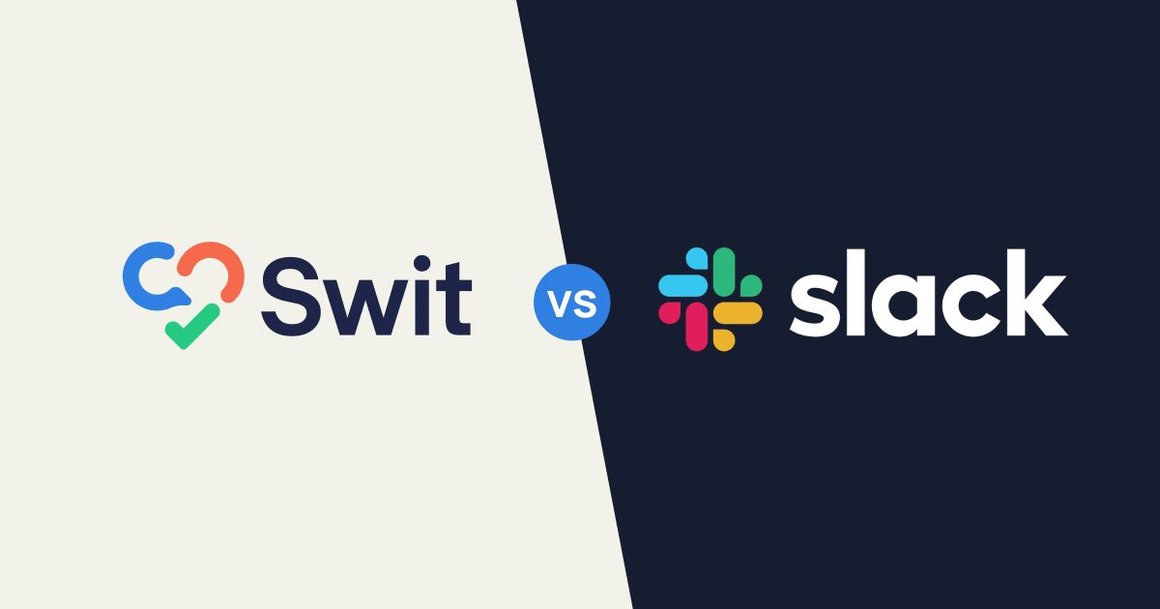
Swit vs Slack: Which is the Best Collaboration Tool?
Use this comparison guide to find a Slack alternative
December 4, 2023
Swit is a SaaS integration platform that connects your entire organization, streamlines team communication, and adapts to any workflow. With channels, task cards, plug-ins, and integrations in one hub that supports multiple workspaces, Swit is a Slack alternative that allows you to have your work essentials in one place.
Slack connects employees within a single workspace through channels, audio clips, and huddles. It can be set up to receive notifications from other project management software, but does not fully integrate their functionality.
When choosing the best collaboration software for your business, it’s important to know what the differences and similarities are between these two collaboration tools so you can choose the right fit for you.
What Do Swit and Slack Have in Common?
Swit and Slack both have channels that let you message coworkers regarding company announcements, the status of projects, or any other type of internal communication.
You can organize conversations by creating channels for different departments and projects for a more streamlined workflow. Create private channels when discussing sensitive information or public channels when collaborating with your entire organization.
Both Swit and Slack have direct messaging capabilities that allow you to talk to a select person or group of people about projects or sensitive materials. They have security features that allow their admins to control who has access and visibility to certain channels and projects.
You can integrate outside apps with both platforms in order to enhance transparency within your workspace. Perform searches to find certain keywords or files, share files, and view employee profiles and org charts.
Swit and Slack both contain features that allow guest vendors to access your organization. They both aim to reduce email threads with business partners by allowing them to communicate in channels and share files directly with your team. With both platforms, you can control which channels and projects your guests have access to.

What are the Main Differences between Swit and Slack?
Swit focuses on organization-wide collaboration, so you can create multiple connected workspaces within one organization. Swit’s right panel supports multitasking with a UI that allows users to manage tasks, projects, and integrations all within one screen. You can then collaborate between multiple workspaces to share messages, files, and projects.
Slack only supports the creation of a single workspace with multiple channels, but not multiple workspaces. Slack is also singularly focused on communication by only allowing channels, whereas Swit offers both channels and projects.
With Swit, you can convert chat messages to task cards in order to keep the entire conversation related to a project in one place. This collaboration tool places a strong emphasis on task management and project tracking with features like task boards, Gantt charts, and project dashboards.
Slack integrations are more about notification management than actual task management. Swit offers a more comprehensive built-in solution for managing projects, keeping track of conversations, and accessing your integrations.
While Slack and Swit both contain plug-ins for Automation and Guests, Swit provides you with two additional plug-ins for Approvals and Goals. The Swit Approvals plug-in lets you submit requests for time off, purchases, emergencies, and other items so managers can directly access your approval requests within your organization.
Additionally, the Swit Goals plug-in manages your OKRs (Objectives and Key Results), letting you track your goals and align them with others as you work on company initiatives, which enhances Swit’s capability as a project and task management tool.
Slack provides video and audio calling features within their app, which may be essential for teams requiring frequent real-time voice and video communication.
The Swit Work OS has integrations with Google Meet and Zoom that allow teams to host real-time meetings at the click of a button without the need for a built-in feature.
Swit also offers more budget-friendly pricing options compared to Slack, making it a cost-effective choice for smaller teams and organizations. Plus, by consolidating your communication tool with your task management tool, Swit saves you money in your software budget by reducing the overall number of tools in your stack.
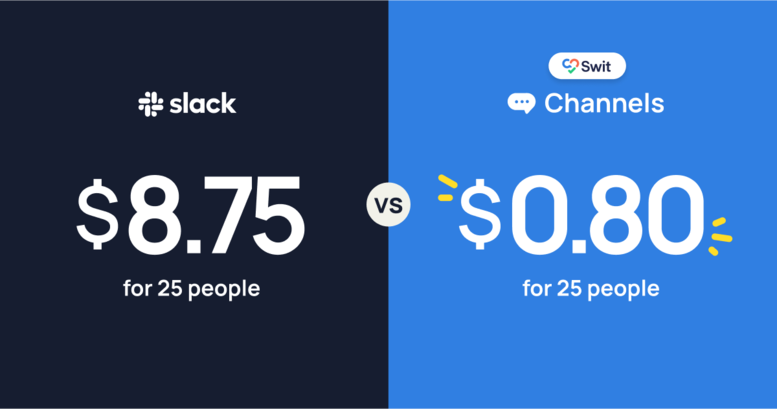
What Are the Pros and Cons of Slack?
Pros
- Extensive third-party integrations
- Established user base and community
- Native video and audio calling features
- Can customize UI in terms of themes and colors
Slack integrates with Trello, Simple Poll, Google Drive, Atlassian, Asana, and more, but only on a surface level through notification management. Slack provides you with video and audio calling features within their app, as well as customization options in terms of themes and colors.
Cons
- Higher prices, especially for larger teams
- More focused on communication, with task management relying on integrations
- You have to use another software for managing your projects
- There is minimal file storage
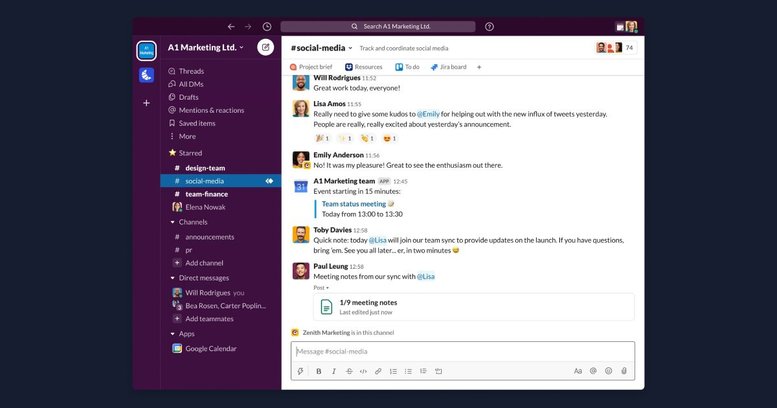
Slack has higher prices for their larger teams and is more focused on communication, relying on integrations to support you in managing your tasks. While Slack may seem affordable when you’re just starting out, it becomes less and less affordable as you grow, which is a hindrance to that very growth.
The Slack Standard Plan comes with 10 GB of data storage per user, the Plus Plan comes with 20 GB of data storage per user, and the Enterprise Plan comes with 1 TB of data storage per user.
The free plan comes with 5 GB of data storage for the entire workplace, so Slack will delete messages, files, and content in channel canvases after ninety days. Because of this, it can frustrate users who send files over Slack versus through email, since Slack continuously deletes your oldest files over time. This makes it difficult to manage and reference work history.
What Are the Pros and Cons of Swit?
Pros
- Budget-friendly pricing options
- Comprehensive built-in task management and project tracking features
- A unified organization-wide structure simplifies collaboration
- Support for plug-ins like Approvals and Goals
- Old messages are never deleted (Startup Plan and up)
- Robust integrations with Google Workspace, MS365, Salesforce, and more
- Combines channels and task cards in one app
- Right panel viewing lets you multitask more efficiently
Swit contains comprehensive built-in task management and project tracking features at affordable prices, making it the perfect Slack alternative. Our unified organization-wide structure simplifies how teams work together through cross-workspace collaboration.
For example, a team from one workspace can share messages and connect projects with a team in another workspace, so multiple departments can work seamlessly together on a project. Additionally, messages are never deleted from the Startup Plan up, allowing you to reference past conversations at your convenience.
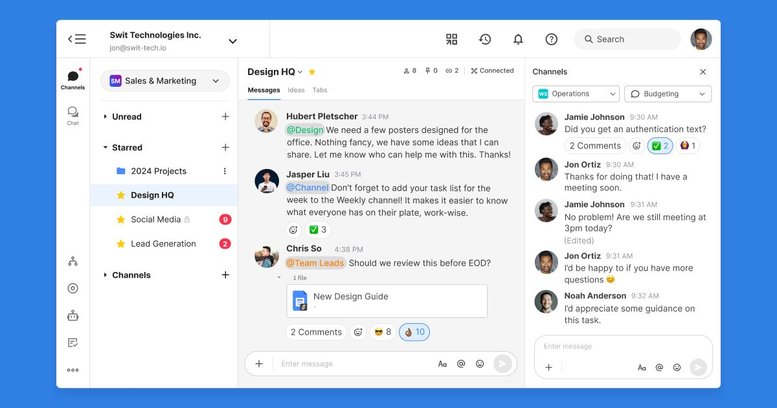
Swit offers our own Guests and Automation plug-ins, and also has native plug-ins for Approvals and Goals. These plug-ins help you keep your essential work tools in one app, greatly reducing the need to switch between programs.
The Swit project management tool also offers stand-alone options for Channels and Projects, in addition to the full Hub plan, allowing you to configure your platform in the way that works best for your workflow.
The Swit Hub plan combines channel messaging and work management into one app, allowing for better interconnectivity between work functions. Files, meetings, attachments, and discussions can easily be accessed within one place using task cards and integrations. Attach emails to conversations and task cards to keep the context of a project in one place.
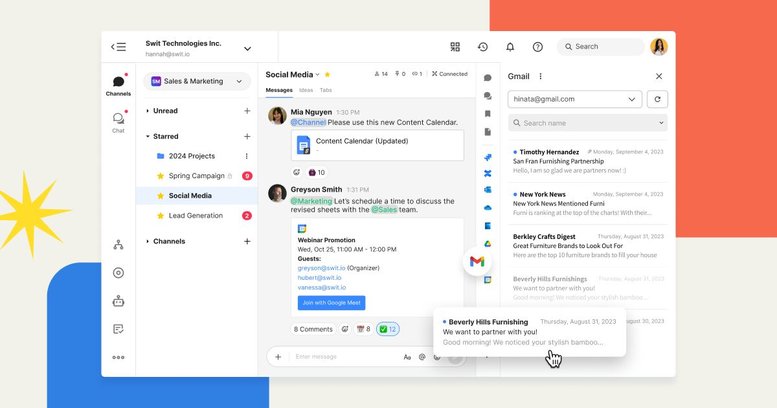
Cons
- More limited options for third-party integrations
- No built-in audio/video calling features
Swit may offer fewer third-party integrations than Slack, but the integrations available give you true functionality of your work tools within Swit. More integrations are being regularly added, and users can also build their own integrations using Swit Developers.
Furthermore, if you were using Slack, you would have to use a task management integration to be notified of projects and still have to leave the app in order to interact with task cards in a different program.
Swit as an internal communication tool doesn't have built-in audio or video calling features, but you can use the Google Calendar integration from within the platform to easily create and share a meeting link if you need to talk with your team at a moment’s notice.
The Verdict: Who Should Use Swit?
The Swit Startup and Growth plan tiers are ideal for small companies or small teams within a larger organization. Plans are easy to scale as your business grows or if your company decides to implement the collaboration software on an enterprise level for all departments.
A few examples of how our customers use Swit:
- HR departments improve connection within their organizations using channels and approve time off requests using the Approvals plug-in
- Sales teams set actions through the Automation plug-in to import leads, keep track of customer requests using task cards, and update the progress of deals through comments and attachments
- Marketing teams coordinate content and design for advertising campaigns through projects, and stay connected to other departments about product releases and events in specialized channels
- Product Management teams discuss development projects in channels and private messages, then convert those discussions to tasks so that there is context for tangible action items with clear due dates and responsibilities outlined
- College students use Swit features to organize group projects and communicate with their classmates
It’s quick and easy to make the switch from Slack to Swit by importing your Slack data into Swit. Still have questions about Swit as a Slack alternative? Contact us and we’d be happy to help answer them for you!
Ashley Mae Orcutt, Creative Copywriter